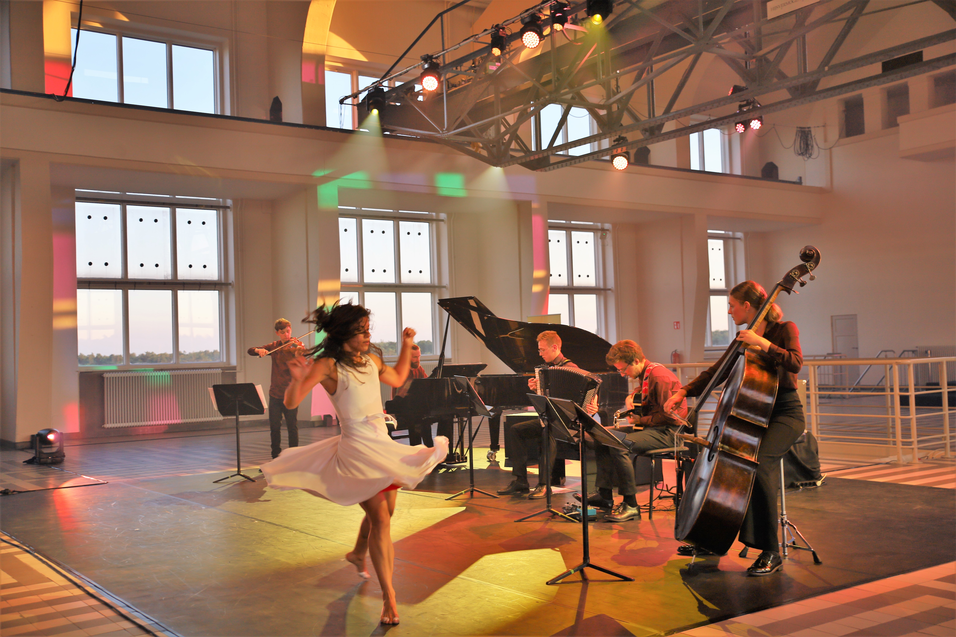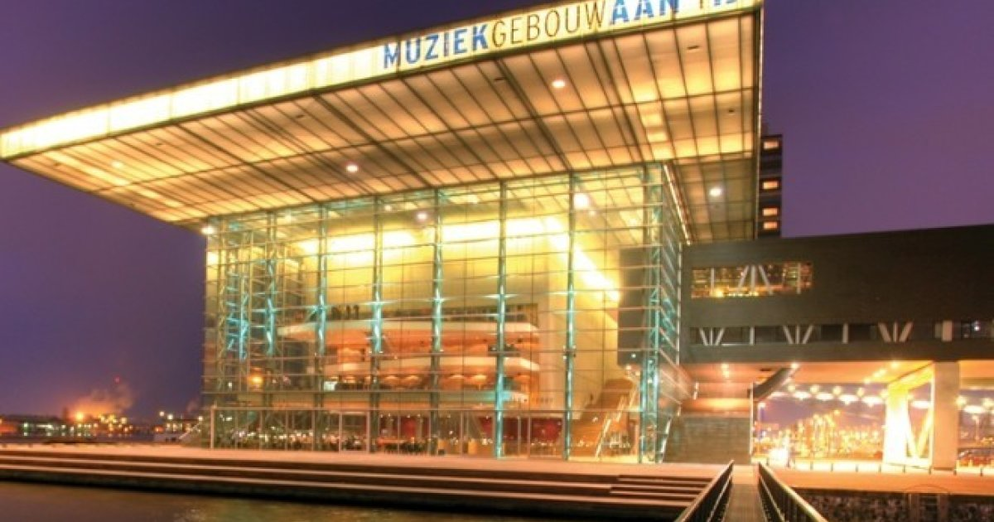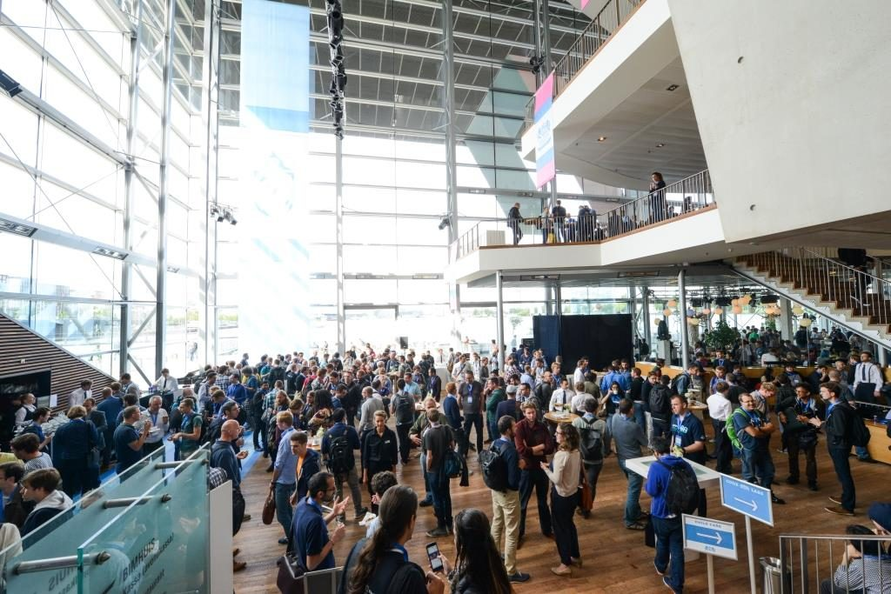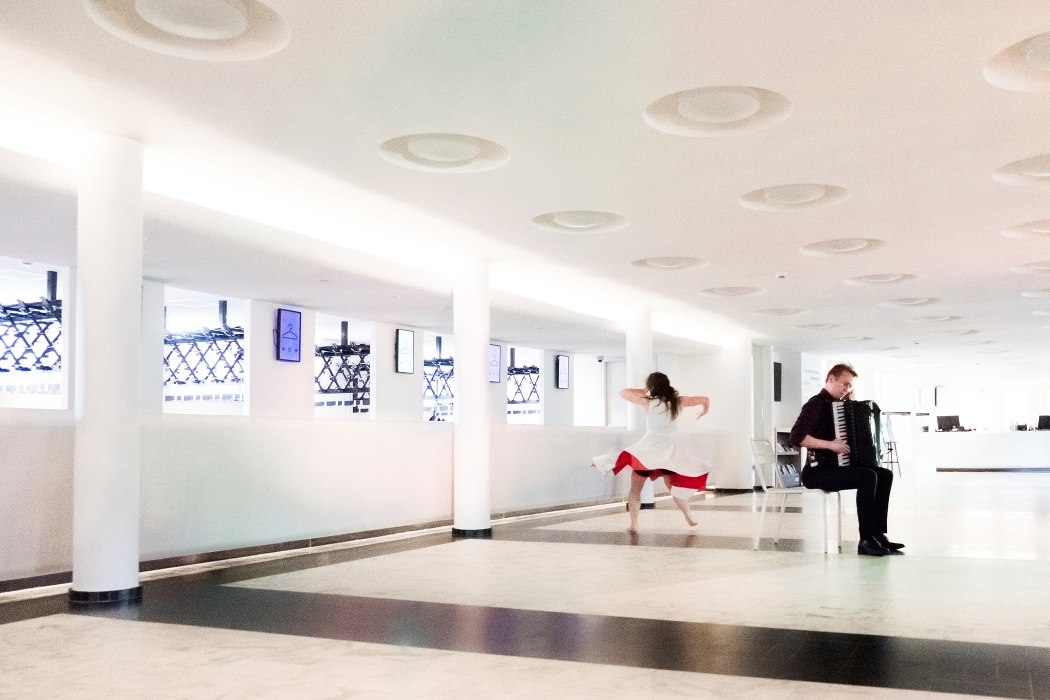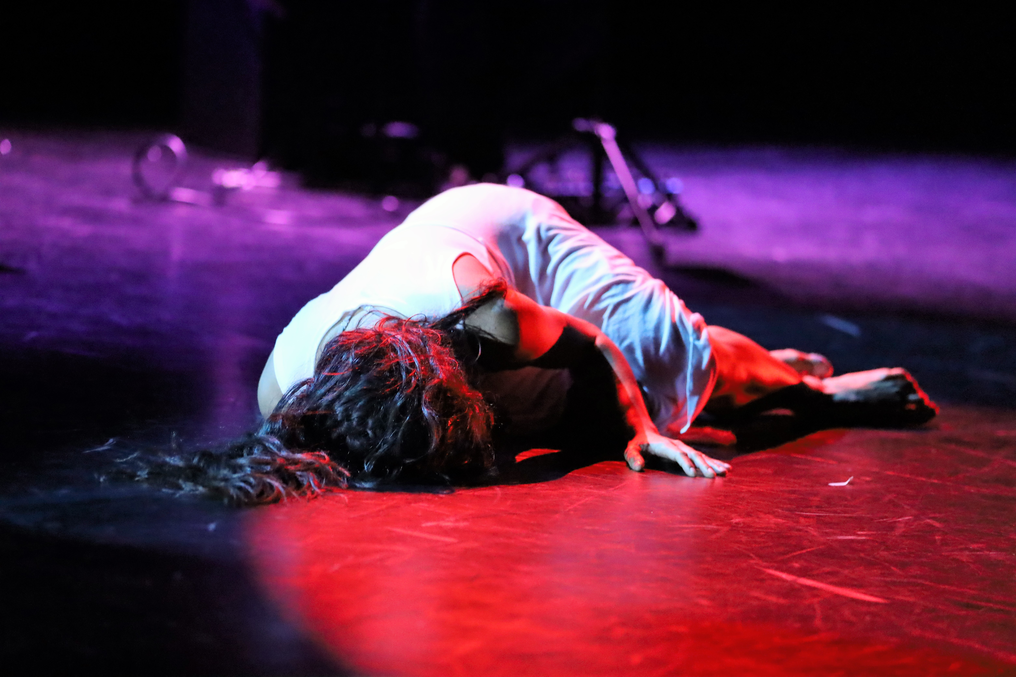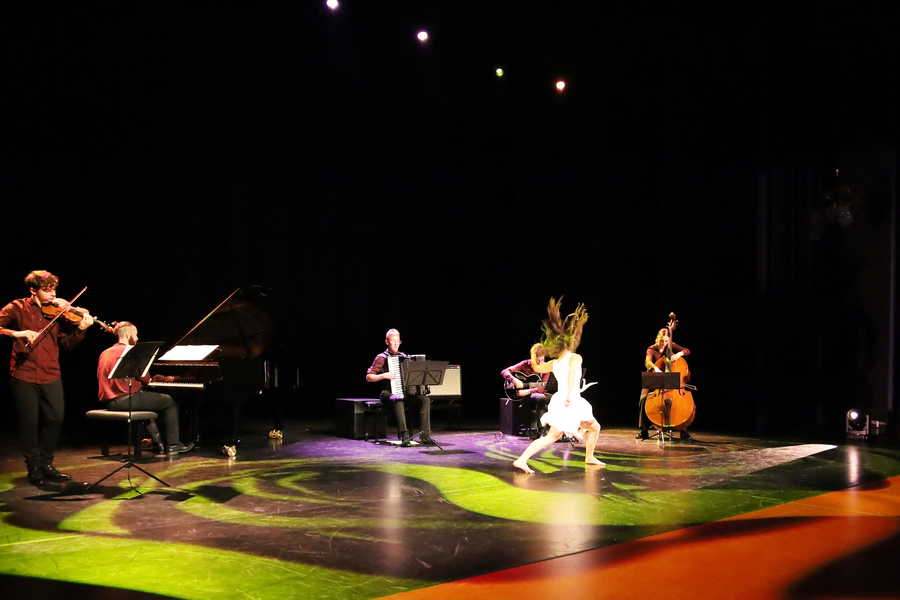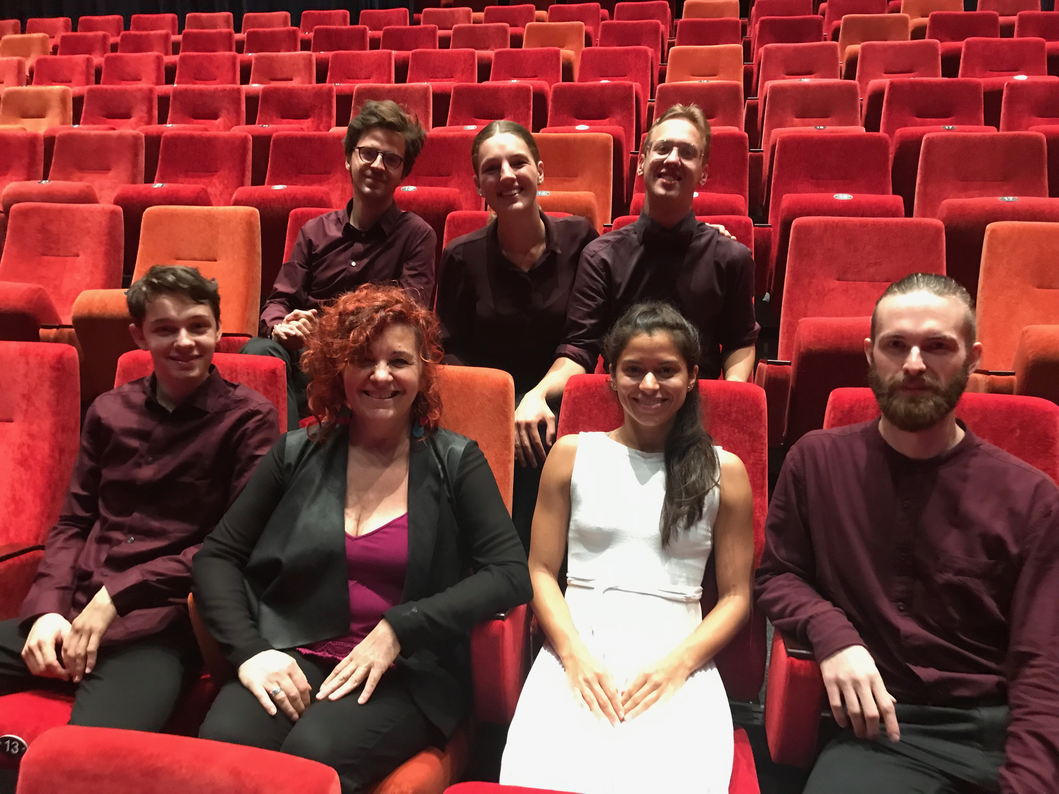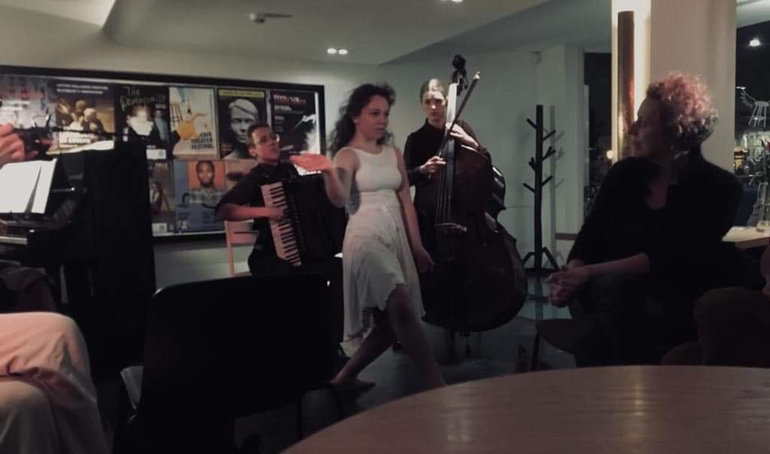'Suite del Diablo', Ástor Piazzolla (13 min.)
I - Tango del Diablo
II - Romance del Diablo
III - Vayamos al Diablo
'Motivy', Emil Tabakov (for Solo Double Bass) (4 min.)
'Escualo', A. Piazzolla (4 min.)
'Sonata IV', E. Ysaye (for Solo Violin) (4 min.)
I - Allemande
'Concierto para Quinteto', A. Piazzolla (9 min.)
From 'Impasse', F. Angelis (4 min.)
IV
Suite 'The Devil on the Dance Floor', J. Gester-Suárez (13 min.)
I - House Dance
II - Asleep
'La Muerte del Ángel' A. Piazzolla (4 min.)
Working on the solo pieces
The element of the angel was present in two of the three solos. The approach was different in each one of them.
Ella’s double bass solo, ‘Motivy’ by E. Tabakov, is interesting to point out for the following reason: the dancer took Ella’s characteristic playing and transformed it into a vertical quality in her movements, which were inspired by the form and manner of playing the double bass. The angelic element was present as well represented in her gestures. Her movements suggested a protective attitude in many instances, achieved by surrounding Ella with her arms or gently touching the instrument.
Daniel’s solo, the Allemande from Ysaye’s 4th Sonata, went for a subtler interaction. In this piece, the dancer would walk in a big circle around Daniel, who had stepped to the centre of the stage. This circle took four minutes for the dancer to carry out. During this slow and intense walking, the interaction that happened between dancer and violinist was contrasting with the generally energetic music that had been played before. The sober and clear actions caught everyone’s attention, especially when both performers looked at each other.
Daumantas’ accordion solo, ‘Impasse IV’ by F. Angelis, was highly energetic to see. The dancer’s movements were clearly influenced by the accordionist’s way of playing. The ostinato quality, very present throughout the piece, allowed an interesting exchange of expressiveness. There was constant feedback between the two, which resulted in explosive moments.
One noticeable quality that gives depth to the idea of interaction is how the expressions were exchanged in this piece. The dancer reacted with mainly two kinds of actions: accompanying and contrasting. The interaction did not necessarily mean imitation. This is something that became clear during the sessions: the interaction originates from a reaction to a stimulus. This reaction can accompany the stimulus or contrast it. According to my experience, the classical academic music environment is slowly opening to improvisation and slowly including it in the curriculum, but the idea of accompanying and contrasting roles has hardly ever been made explicit. It was interesting to realise that an aspect which is essential to dance and theatre is relegated to (elective) improvisation classes in conservatory. In my opinion, these three possibilities are one of the ground ideas that an academically trained musician has to have in mind as a starting point for a collaboration with another performing art.
Shaping the structure
The structure was thought about in a primarily musical point of view, and it was also inspired by how a concert program is created. The idea was to present a journey through the emotions invoked by the pieces we chose and the different dynamics achieved by the combination of solo and tutti pieces. The intense energy we are able to transmit as a group had to be expressed to the maximum. That is why these emotions were of such importance to us and why they were always present during the process.
Introducing the elements of the devil and angel into the program
Before going to the repertoire and how it shaped the final performance, it is worth expanding on the choice of the title ‘The Devil on the Dance Floor’ and what it implied for the concept of the performance.
The name of our ensemble translates to English as ‘The Devil’s Quintet’, which we took from Piazzolla’s ‘Suite del Diablo’. This was the first piece we embarked on as a group. As we had a very close relation to it, we wanted to include the suite in the interdisciplinary project. Immediately, it was clear that, judging by the name of the suite and on the name of our ensemble, the concept of the creation would involve the devil to some extent. In a rather early stage, the title of the project (The Devil on the Dance Floor) was created. We also added the element of the angel to the idea of the devil to enrich the performance. The angel, apart from serving as a contrasting idea, is also a reference to Piazzolla’s ‘La Muerte del Ángel’, the closing piece of ‘DODF’. The work done by Laura Suárez and the dancers (first Goda Žukauskaitė and after 2019, Rosanna ter Steege) was to shape the performance making use of these two contrasting images. The two images were included in the process, and contributed to the work on interaction and each one of the pieces. Each piece had to have its character, so a big part of the intermediate stage of the process consisted of characterising these pieces and making them as concrete as possible.
Working on the ensemble pieces
Through experimentation, a convincing result was gradually shaped. This experimentation was supervised by the director, who narrowed down the palette of resources. The resources included the gestures we used, how we were placed on the stage, and which emotions were present in each piece.
Most of the repertoire the Quintet played was already composed. This meant that the musical text was less malleable from the beginning than the other aspects. However, there was still room for including the devil or the angel elements in these compositions. In ‘Tango del Diablo’ and ‘Vayamos al Diablo’, the dancer was clearly conveying the image of the devil. She was possessed by the music and adopted a grotesque behaviour. In other tutti pieces, the image of the devil was still retained in the energy of the performers, especially in the louder, intense, and rhythmical parts. However, it was not as explicit as in the previous ones. This can be seen in ‘Escualo’ and ‘House Dance’, where the mood is relaxed compared to the other compositions, or ‘Concierto para Quinteto’, which is long and transits through different characters. Nevertheless, when the music became more energetic, a strong and almost aggressive character was perceptible.
- Structuring the narrative according to levels of interaction and activeness.
The choice of the pieces implied an arch in terms of the activeness of the interaction. This activeness was composed of both the gestures or actions themselves, or by how physical these gestures were. The physicality of the action refers to the extent to which the senses are involved in each case. When the concentration is in these senses, the result is intimate, subtle and powerful in its simplicity. This is a principle we learnt from Laura Suárez, and is expanded upon in the interview with her.
The dancer’s discipline is based on movement, which catches the eye more than the musicians do. This gives her the opportunity to receive as much attention as the musicians, and to take a leading role at several points in the performance. To enrich the levels of interaction in the ensemble, it was essential to apply the techniques of leading, accompanying and contrasting roles to all of the performers, including the dancer. For example, the second movement of the Suite del Diablo (Piazzolla), the dancer’s action was to ‘melt’ for six minutes and end on the ground. In a piece in the middle of the performance, the nine-minute long ‘Concierto para Quinteto’, the dancer’s role was toned-down, and consisted of approaching each one of the musicians and experiencing physical contact with them in a very delicate way, which resulted in very slow actions. The reason for this was to give the quintet a moment to shine in this rather difficult and virtuosic composition. The interaction was very special and subtle, as each one of us had a moment to feel her either sitting by our side, gently hugging, or other actions depending on the player and their instrument. At the end of the piece, the dancer’s actions developed into a more active role, after approaching each musician. However, the powerful impression in this section came from the intimate relation that took place by focusing on the senses, especially touch and sight, all in the context of the expressive and lyrical parts of the piece.
Adaptation to different venues
“The Devil on the Dance Floor” was performed in venues that were very different from each other. This meant that the performance had to adapt to these venues. There are three instances of the project's adaptation to a venue that are worth mentioning, because they demonstrate the different possibilities that a venue can provide and how to use these possibilities.
- Echoes of Nothing, Muziekgebouw aan ‘t IJ (main entrance), 2019
In december 2019, ‘The Devil on the Dance Floor’ was part of that month’s edition of ‘Echoes of Nothing’, a series of performances organised for and by CvA (Amsterdam Conservatory) students. The idea behind this series was that students and alumni from the conservatory would present smaller performances in the main entrance of the Muziekgebouw aan ‘t IJ in Amsterdam. These performances would complement the concert that was presented in the main hall. In our case, the main concert had a program based on South-American Baroque music, which combined well with Piazzolla’s music. Piazzolla, apart from being an Argentinean 20th-century composer who merged tango with other styles, especially jazz (from the addition to his ensemble of the jazz electric guitar to the use of complex rhythms), was influenced by the Baroque style in his use of clearly defined melodic sequences and progressions such as lamento bass, monte bass, and descending fifths. His music has also a clear presence of counterpoint that is also treated in a Baroque way, especially in the use of fugato passages (see the beginning of ‘La Muerte del Ángel’) that can be found in much of his oeuvre.
The space was non-conventional and had very impressive features that could be taken advantage of. In the pictures, it is possible to see how the stairs and balconies give many different places to perform. We wanted to use these qualities to enrich the existing performance. Generally, the performance did not suffer limitations by the space itself, at least in the visual sense: some performers would be able to move rather freely (except for the crowd that went out of the main hall and sometimes obstructed Rosanna’s movements), which would give us the possibility of using one balcony for the violin solo, and another for the accordion solo. However, during the performance we encountered one problem that was not planned and had to do with one quality of the space. As opposed to CTF, the acoustics in the entrance of Muziekgebouw were very wet. If the quintet was not playing together, the sound would disappear in the chatter of the public, especially during the double-bass solo. This mistake could have been solved the same way it was solved in CTF - with a sound technician - but, in this case, this was not prevented and the budget was rather restricted. This experience showed the importance of being aware of every aspect that shapes a performance and how it can - in this case - negatively affect the final result if left unattended.
- Café Theater Festival Utrecht 2019 (CTF)
‘Café Theater Festival’ is a festival which takes place in cafés around the city of Utrecht in early spring each year. Our series of performances (eight in total) took place in March 2019 in the Café Mevrouw de Dudok, a small café in the building of the Stadsschouwburg Utrecht.
As it is noticeable in the videos, the space had several architectural and acoustic qualities that posed a challenge for the performance. These were the main aspects that were different from the average theatre or concert hall:
- Placement of the cafe: Inside the building were two rows of columns and the café was placed between them. One of the rows separated it from the entrance, where the wardrobe was and where people would walk by to go to the main hall, and the other separated the café from the windows facing the street. The space in between was around 2 meters wide. In total, there were three corridors, three ‘tunnels’ as I called it in the notes taken during the first visit to the place. What was very interesting was that each ‘tunnel’ had a different quality: the space between the café and the window did not have people walking around, so it allowed a potential intimate moment to happen. The middle space, the café, was crowded but with people sitting, which would give the dancer other possibilities of interaction with the public. The biggest space was the corridor that connected the entrance of the building and the main hall, with the wardrobe, which was in between, parallel to the café. This meant that the public in this area would walk in, stop to watch and eventually continue walking, either to the exit or to the main hall. These qualities were an advantage to give dynamism to the initial performance due to the different places in the building that we could use. The conclusion was that it was best to use the middle part, the café, as the place where the musicians would be, because we fitted in it and because we were also more ‘protected’ than in the wardrobe corridor, where people would walk by casually. This would have been dangerous for the instruments and would not contribute to our concentration.
- Very limited space for performers: Between the two rows of columns there was an area of 2x5 meters where we should fit four musicians, including an upright piano and a double bass. The dancer, who was Goda Žukauskaitė at that time, had the possibility to move in the smaller corridor between the tables and chairs of the café, and in the other two ‘tunnels’.
- Low ceiling: It gave a somewhat claustrophobic feeling, but it also had concrete consequences. The most important threat was to Daniel Leenders, the violin player, who had to be careful not hitting it with his bow. It is worth noting that the area of the wardrobe had a slightly higher ceiling, but, as said before, the space was too exposed for us.
- Dry acoustics and high volume of chattering coming from the public, both the one going to the main hall and visitors of the CTF. The above mentioned qualities had a big impact on the acoustics. Luckily, we had the chance to work with a sound technician. He was able to amplify us and even add a subtle reverb, which improved our sound significantly.
- Another limitation was that the festival required a performance of around 30 minutes. Therefore, we had to cut half of the repertoire (the performance was one-hour long) and leave out most of the subtle and quiet moments, as the attention from the public was not per se guaranteed. We were left with the two movements from the Suite del Diablo, the accordion solo, Piazzolla’s ‘Escualo’, the violin solo, and ‘La Muerte del Ángel’ as a closing piece.
For the occasion, we worked with Argentinean light designer Leandra Rodríguez and custom designer Susana Zilbervarg. Their contribution enriched the performance, thanks to their art forms. The inclusion of these visual art disciplines within the framework of a well-functioning performance proved to enhance the expressions and give depth and cohesion to the greater picture. It was clear that including other art forms to the existing performance helped it grow and develop further.
Applying the work to the final performance
The work during the rehearsals helped establish a different perspective on the possibilities we had as a group to interact with each other. In the final performance, however, the interaction was unlike the dynamics we realised during the rehearsals. First, because the musicians never acted without leaving their instruments. This resulted in subtler gestures: sight, as a powerful means of interaction; and movement, within the limitations posed by the instrument itself. Another important aspect of the final performance was that the fundamental trigger for the dancer’s gestures came from the music that was played; these gestures were highly influenced by this trigger. Nevertheless, sometimes the musician’s body itself was the seed for the gestural interaction that happened between both disciplines. This could be very noticeable in the three solos of the performance: Ella Stenstedt on the double bass, Daniel Leenders on the violin, and Daumantas Stundžia on the accordion.
In conclusion, the pieces, be they solo or tutti, were the units that shaped the structure of the whole performance. The difference between the pieces was noticeable to the dancer as well as to the musicians, and it was deliberate. However, other elements had a strong influence as well. These elements were external to the music and the dance themselves and added another layer to the performance. They were the image of the devil, contrasted with the image of the angel.
Since 2015, I have taken part in an ensemble called Quinteto del Diablo. We play mainly Argentinean New Tango by Piazzolla, plus some compositions written by me and some arrangements of other composers. The members are Daumantas Stundžia (accordion), Ella Stenstedt (double bass), Daniel Leenders (violin), Piotr Lipowicz (electric guitar), and Joel Gester Suárez (piano).
For around two years, we played around at the conservatoire, not looking for many concerts, but building a well-functioning and productive group. It was in 2017 when we decided to expand from purely performing music to collaborating with other forms of art. The first art form that comes up when mentioning tango is dance. Apart from the fact that tango is a dance (although Piazzolla’s music was not explicitly meant to be danced), dance is an art form that resembles music in the abstract sense of the discipline. It does not need words to function. Therefore, we started looking for someone to be the dancer in a project yet to be created. Our first dancer was Goda Žukauskaitė. She participated in the project until 2019 when we started collaborating with Rosanna ter Steege. We had our first rehearsal in January 2018. Additionally, my mother, Laura Suárez, who is an actress and director based in Madrid, offered us help in a role we later called ‘stage director’. She was not explicitly a choreographer, nor a musical supervisor. She watched the process through the lenses of someone whose expertise is theatre. From the beginning, the Quintet thought this was promising: the insight she gave came from the theatre discipline and shaped the process in a very unique way. The result was a performance with not five musicians and one dancer, but six artists who equally participated in delivering a strong interpretation. What were the keys to achieving this? How did we develop into an organically-functioning ensemble? Understanding this process and its components has helped me enormously to create a framework for interdisciplinary performances and my current project with Rosanna Ter Steege.
Apart from the highly relevant interview with the director Laura Suárez in the following section of the research, Rosanna and the members of the quintet also reflected on the process and their experience with it. Their insights can be seen in appendixes 1 and 2, respectively. These appendixes give an interesting point of view and, in many cases, reveal that the group was very cohesive and had a similar experience of the process.
Building interaction within the group
The first rehearsal we had was a clear example of how not to start working on an interdisciplinary project. We got together and simply played through some of the pieces, while Goda danced around. At that moment, the interaction was poor: we did not perceive each other; the dance was a foreign element to us. However, through the sessions we had later with the director Laura Suárez, we were able to focus significantly on building a strong interaction. We achieved this through different group dynamics, which were exercises with precise guidelines to work on the cohesion of the group. Many of these exercises were based on the perception of oneself, the group and the space we were rehearsing (or later performing) in.
Collective sessions with director Laura Suárez
The key to the group dynamics was, as the word suggests, to work as a group. Many of the exercises had the goal to free ourselves from the instruments, and to use body contact and movement to interact with each other.
As we can read in the interview with Laura Suárez, the interaction starts in our senses. From our perception of ourselves, we opened these senses to the other members. The last step was to open our perception to the space we were in. As a result, we would perceive the whole group as a unity within the room. This level of ‘deep interaction’ allows the group to eventually step out of the close contact and explore other ways of perceiving each other and interacting with each other. This subtle and underground work has allowed a very unique performance to happen.
There was a notion of equality during the process, which also enriched our creativity and openness. This notion proved to be ideal for a well-functioning ensemble.
Another important aspect of the group dynamics was to work without the instrument. This facilitated the possibility of using our bodies and getting to know them in-depth. As Laura Suárez observes during the interview, “I [Laura] found it very interesting to explore the possibilities that these bodies can express at a scenic level. In this way, you would turn into scenic performers, apart from musicians”. We can find some of the group dynamics in the video to the right.
- NJO Muziekzomer Festival 2019
In the summer of 2019, ‘The Devil on the Dance Floor’ was performed in the NJO Muziekzomer Festival that takes place in different locations in the province of Gelderland. We were programmed at Gelderlandsfabriek in Culemborg, Theater De Leeuw in Arnhem, Radio Kootwijk in Apeldoorn, and Veluvine in Nunspeet. The ensemble incorporated Piotr Lipowicz on the electric guitar and dancer Rosanna Ter Steege as new members, and the light designer Teus van der Stelt as a highly important collaborator.
Teus’ work contributed, as happened with Leandra, to already create a space within the venue. It became an essential part of the performance as a whole. This is why the music and dance parts did not need to change substantial parts in the festival, apart from the fact that we performed in conventional venues.
Although the research topic focuses on the performance arts themselves, it is important to stress that light design is essential to achieve a rich - and complete - performance. About this topic, Peter Mumford states in "Lighting Dance.":
“Those who agree that it is sufficient simply to illuminate a space to an acceptable level of visibility, maintain that ‘the dance is the thing’ and all else mere periphery. [...] The very decision to work in a hall, lit by fluorescent tubes or using a plain cover of ‘white’ light on stage, is, for instance, a design decision that will affect and control responses to a performance. [...] There is, properly, no such thing as working without costume, set or lighting”.
Mumford, Peter. "Lighting Dance." Dance Research: The Journal of the
Society for Dance Research 3, no. 2 (1985), 46
Although the citation is focused on dance, it is relatable to any other performing art. Lighting is an art form in itself, as was proved by Teus’ work. He was in frequent contact with the director Laura Suárez to ensure that the performance (musicians, dancer, customs and lighting) were functioning as a cohesive unity. In the photos and videos we can see the extent to which light design participates in the performance as an entity. We can see how it gives expression, enhances the images, and focuses the attention on the different elements (dancer or musicians) throughout the performance. This is noticeable in the videos and pictures taken during the festival.
Project “The Devil on the Dance Floor”
with Quinteto del Diablo, dancer Rosanna ter Steege, and director Laura Suárez
Conclusion and motivation for research
After my experience with ‘The Devil on the Dance Floor’, I was convinced that I wanted to work further on interdisciplinary performances, and to include theatre and dance in future projects. However, it is clear that these kinds of performances require a huge amount of focus in each one of the components that shape it. I learned about the importance of being aware of how everything is shown on stage, and how every component of the process is connected. As performers, we must be aware of this connection, because it is the basis of creating a cohesive performance. For this, we need a common way of relating to each one of these components.
During the rehearsals, we built a group expression, whose idea was to deepen into the awareness of our individual qualities as performers. These qualities connect to each other and translate to a unity that is multiple at the same time. The performers had, therefore, the same importance as the concept and the more abstract components in the process and performance, such as the structure, the image of the devil and the angel, and the written music. The work on these components was essential as well, but it only provided half of the picture.
As Norbert Servos states in the book ‘Pina Bausch. Dance Theatre’, “a collective knows more than what a choreographer could ever get to know” (Norbert Servos, Pina Bausch. Dance Theatre, p. 418). This affirmation is essential to understand the work we carried out with Laura Suárez, who uses much of Bausch’s way of relating to performing arts. This is why our early rehearsals were focused on achieving this group expression. At the same time, the concept, the pieces, and the structure were being thought out and planned. These were later linked to the group expression during the rehearsals. The collective expression, in the case of ‘The Devil on the Dance Floor’, was an theatrical exploration of dance and music. Our project was not alone in this idea. Looking at the work of big personalities in the world of performing arts, especially German dancer and choreographer Pina Bausch, we can observe how artists and creators have been (and are) very keen on merging qualitatively opposed disciplines in the last decades. In Bausch’s case, she mostly focused on dance and theatre. David W. Price explains it in "The Politics of the Body: Pina Bausch's ‘Tanztheater".
“What distinguishes Bausch, however, is the development of an art form based upon a binary opposition that does not reproduce an either/or dichotomy; instead, Bausch’s productions are both dance and theatre. Hers is a form that rejects a totalizing Wagnerian vision in favor of a dialectical theatricality”.
Price, David W. "The Politics of the Body: Pina Bausch's
"Tanztheater" (1)
What can be drawn from these texts, together with the experience with ‘The Devil on the Dance Floor’, is that the components of the process and the final performance consist of distinct qualities, and different ways of handling these qualities. It seems, at the end, that the main idea comes from two opposing thoughts: each one of the components have their own inherent and individual characteristics, but these components function as a unity. This unity is multiple, malleable, diverse, and open to include new or modified components which are incorporated in this unity. In the case of ‘The Devil on the Dance Floor’, some examples are the different venues we performed in, which was a modification of the components of the space, and the work with lighting and custom design, which was the inclusion of a new component.
To understand the components that shape an interdisciplinary creative process and performance, it is important to discuss their behaviour. Therefore, the solution is to construct a framework where these components are taken into account and placed in an interconnected map: the map of components.
FOLLOWING SECTION:
- Structuring the performance according to the music.
It was mainly the quintet that decided the order of the pieces to make a proper dramatic arch, and we always kept in contact with the rest of the group. The performance would start and end with the ensemble playing Piazzola, which is what we specialise in. It is a highly dramatic and energetic repertoire that can be taken advantage of by the dancer. The structure, which very much resembled the one of a conventional concert, aimed for an organic combination of fast and slow pieces, as well as tutti and solo pieces. The three solo pieces, scattered through the performance, had a key role in the dramatical arch, both in decreasing or increasing the tension.
In this video we can notice the change in the level of tension from the first movement of my piece, 'House Dance', to the second, 'Asleep'. The activity falls down and the rest of the components follow this change in the energy. Both Rosanna and the quintet calm down, and the lighting follows with colder colours.
Slideshow of pictures taken by Jan Koldewijn and Göran Gester during the NJO Muziekzomer Festival 2019.
Example of a collective session: first rehearsal on the 25th of February 2018.
The session starts with a warm-up, a guideline (holding each other's hands in pairs and let the body lean back, while keeping balance) which leads to a freer group experimentation, a cooling-down, and to end, we went to our instruments and played.

